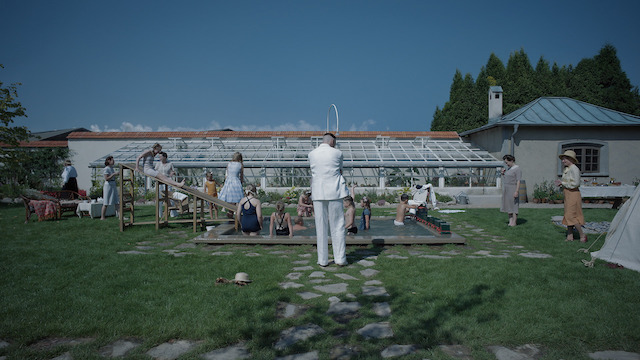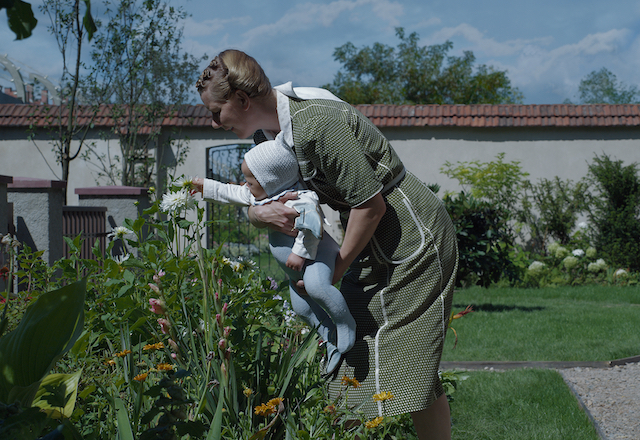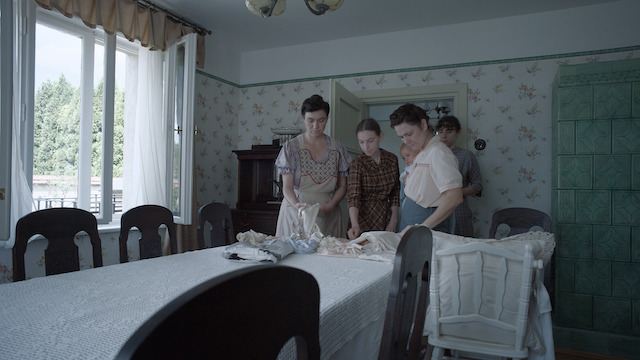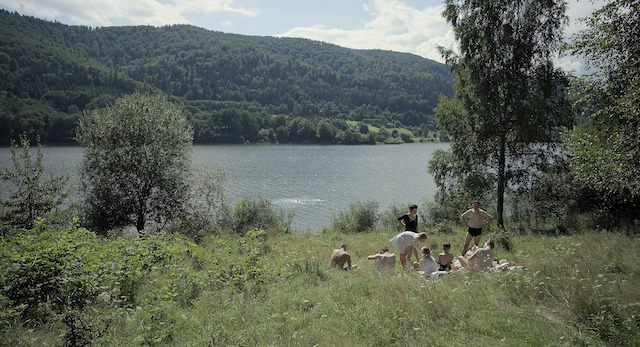
The Zone of Interest : The commandant of Auschwitz, Rudolf Höss, and his wife Hedwig, strive to build a dream life for their family in a house and garden next to the camp.
Rating: PG-13 (Smoking|Thematic Material|Some Suggestive Material)
Genre: History, Drama, War
Original Language: German
Director: Jonathan Glazer
Producer: James Wilson, Ewa Puszczynska, Jim Wilson
Writer: Jonathan Glazer
Release Date (Theaters): Limited
Box Office (Gross USA): $487.0K
Runtime:
Distributor: A24
Production Co: A24, Access Entertainment, Film4, JW Films, Extreme Emotions

@Courtesy of A24
Press Conference with Director Jonathan Glazer and Producer James Wilson
Q : What was the initial discussion you had about converting Martin Amis’ The Zone of Interest into a film?
Jonathan Glazer : What happened is I read a preview of the book in a British newspaper in this sort of book supplement and immediately there was something about it which was relevant to the conversation that Jim and I had been having. I sent him the little capsule preview and we started talking about that. Of course after reading the book we started a more in depth discussion.
James Wilson : It’s exactly what John said. Just after Under the Skin arrived in theaters we started talking about a film with the subject the Holocaust. We looked at a few things: different stories, books. It was something that was in both of our consciousnesses for a long time. And it was always about how to address the subject in a way that was dynamic, had something to say that was different to what had been said or portrayed before. The thing that was captured in that little preview was this perspective on the life of a concentration camp. In the book it’s a fictional concentration camp and a fictional commandant, but you’re largely in the point of view of the commandant and his family, drawn into his domestic world and his work world. It instantly seemed very interesting, a reverse angle from the way the Holocaust is traditionally narrated.
Q : What was the most appealing thing about reading Martin Amis’ Book?
Jonathan Glazer : I was interested in trying to find a perspective that was perpetrator based. The novel in some way gave me some kind of permission to take it on. It’s an extremely uncomfortable place to put oneself artistically for obvious reasons. But there was something very courageous in his attempt that helped me with mine. I certainly didn’t read the book thinking I was going to adapt it faithfully. It was much more of a sort of a kernel. I had a really powerful feeling from it. I started to investigate the source text, the real figures that Martin Amis made fictional. What he had written was clearly based on the real commandant of Auschwitz Rudolf Höss, so I started to read about the real man and by extension his wife and his family, his private world.
Q : When did you decide to discontinue following the novel and start incorporating your own idea?
Jonathan Glazer : I read the book and I put it away. I read it three or four times over the course of nine years, but Initially I didn’t really revisit it. It was almost like I was trying to absorb what it left me in terms of feelings, so I started to investigate those.
Jim and I had lots of conversations, we started to read and share reading lists with each other and point each other towards those things that have picked our interest for one reason or another. You just begin to create a sort of orbiting ideas and images from all of the research you’re doing. I remember clearly that the writing started for me in Poland, we were on a research trip.
James Wilson : The book is written in English but we never, for one second, entertained the idea of making the film in anything other than its native languages. Under the Skin also departed very much from the book. It was very much a spring, a jumping off point in the way John’s described with The Zone of Interest. I remember John started in the development more faithful to the book when we did Under the Skin, there were drafts of scripts that were more faithful to the book, that was never the case with The Zone of Interest. We optioned the book at the end of 2014.
I think there was a brief thought about Amis’ story of a love triangle But I remember Jonathan saying: “I don’t want Auschwitz to be the backdrop for a foreground story”, and I felt the same. We really just spent several years gathering material about the Höss family, almost in a sort of ritualistic way, not knowing what the film would be. So the journey of development of the film is in itself a sort of process, an interesting creative process. Like molding without knowing the sculpture you’re making. The story of Aleksandra, the Polish partisan girl who’s leaving food for prisoners, comes from a completely organic part of research. That was part of the years of shaping the material.

@Courtesy pf A24
Q : What is your opinion of The Zone of Interest’s appeal to a contemporary audience? What is the movie’s perspective on what is happening in the present day?
Jonathan Glazer : That’s the reason we made it. The idea of the project was: how can we tell this in a way that it resonates in today’s world? How can we make a film that talks about something somehow more primordial, something that lies underneath, the human capacity for violence and that we have as a species? We wanted to show the familiarity of these perpetrators: they weren’t anomalies, they were normal people who step by step became mass murderers and so disassociated from their crimes that they didn’t see them as crimes The methods we used to make the film had to serve that idea of something that had very much a 21st century lens.
James Wilson : I agree completely with what John said. There’s lots of very eminent Holocaust historians and philosophers and we steeped ourselves in all sorts of reading and discussion. We have done work against this idea of sacralization of the Holocaust as the philosopher Gillian Rose termed it, whose work we encountered actually in post-production, but was a real sort of late inspiration for us. The Holocaust in some way turned into the realm of myth, it has become mystified as a sort of evil that descended like a sort of reverse manner from heaven.
That’s ultimately a way of sort of sealing it off. It’s sort of politically a conservative way of thinking about it, we hoped that by dressing it in this way we could see some kind of mirror of ourselves in it. A script editor we were working with, a German script editor in the early or the mid part of the development had this line that we always thought was a great criteria: “Perhaps the question of this film is not how could these ordinary people do such terrible things, but how much we look like them? I think that it isn’t only about now: It’s about before these events. It’s hundreds of years of history. It’s ongoing. It’s a continuum.
Q : What was the nature of the conversation you had with the cast? What was your method of introducing them to these complex, almost disconnected characters?
Jonathan Glazer : Sandra Hüller in particular was very reluctant to get involved with the project. And it was because Christian Friedel and Sandra have probably been asked many times before to portray Nazis. Both of them had a real, and rightly so, antipathy towards that, because there is something where somebody just pulls on a hat and puts on an SS uniform and it’s like cosplay. There’s almost this feeling of empowerment.
When I explained to them how I was going to do the film, the point of the film, they understood that there was no fetishisation involved in it whatsoever, quite the opposite. So I think we shared the same doubts going into the project, and I think that’s actually what galvanised us all, and that would extend to the crew as well. There were plenty of times when we would privately or in groups talk about where we were, our own journey, where we had found ourselves. We weren’t in a movie studio a thousand miles away from these events, we were 50 meters from the walls of Auschwitz.There was undeniably a power and a concentration that came with that proximity and I’m convinced that the atmosphere is in every pixel of this film.
Q : What do you believe is necessary to prevent these things(Holocaust) from happening in the future?
Jonathan Glazer : I think we have to evolve out of our capacity for violence. I refuse to believe that we can’t evolve out of it but it’s absolutely necessary that each of us has to deal with it The film is about our capacity, the possibility of each of us being a perpetrator: what we choose to love, who we choose to love, who we choose to empathize with and who we decide not to. It’s a very complex set of circumstances. But I think fundamentally, it is an interior examination. What the film is trying to achieve is almost to connect subconsciously to the viewer.
Q : Can you talk about the collaboration with Mica Levi and the process of creating an original and haunting score?
Jonathan Glazer : Mica and I have become very good friends over the years. I was introduced to Mica when I was looking for a composer for Under the Skin. There was something so unique in her work and her approach that after listening to about 20 seconds of Mica’s original material, I wanted to meet her immediately. I think we have a very good chemistry together, creatively speaking. Our process is to sort of be around each other. It’s very hard to specify where one’s work begins or ends. Our relationship creatively is really like sort of having a nice long walk together. We are immersed in the work together.
Mica wrote so much music for The Zone of Interest. She’s been in the room with me and the editor Paul Watts for about 10, 11 months. There’s that beautiful sense of being completely attached Mica has to something that she’s making, and at the same moment unattached.What we are always looking for when we work together is the intersection of music and picture, is that third thing that is created as a result of the union of those two things. We’re very tuned into what we are looking for in terms of how it should feel. We want to surprise each other all the time. So the project is always something evolving until it feels right.

@Courtesy of A24
Q : Jonathan, could you elaborate on the decision to begin and end the film with a black screen and music?
Jonathan Glazer : I didn’t write it like that. This explains something of the process of what I was chasing and how I was feeling.The images and the scenes, all of the stuff you create and construct is in some way the scaffolding for those feelings. On the one hand, we’re making something which is sort of very realistic in so many ways. Dogmatically realistic. But there’s something that needs to be felt behind those images, underneath those images, around those images.
That aspect of the film is expressionistic. Mica and I understood that, as the sound design evolved and developed, the music had to prepare for something. And that happened before the images, like creating an emotional experience before the first visual frame. There was a sense of explaining that the ear was not only important but should precede the eye in terms of importance.
And the same thing happens in the end, where we submerge while at the beginning we used the music in order to surface. Sometimes the music gives me an opportunity to comment in a way that the picture simply can’t. The music informs the edit, the edit informs the sound, the sound informs the visual effects, the visual effects informs the music and so on. So I like to keep everything alive until you find a unity of all those ingredients.
Q : Although the sound design in the film is subtle, it plays a crucial role in the storytelling. Can you describe your approach to sound designing?
Jonathan Glazer : There was no desire from me whatsoever to reenact any of the atrocity or recreate it visually with extras and actors. Sound can paint those pictures in our minds. So the sound design needed to really be hell in some way, it needed to represent all the range of horrors. It was all very very carefully researched by the sound designer Johnny Byrne. I am talking about huge amounts of research, witness testimony, and a lot of drawings by prisoners who did or didn’t survive.
Drawings that were done in captivity or after the war, which were very dependable, evidential guides for Johnny and myself. So we began the same process that we used for Under the Skin, which involved huge amounts of field recordings. Johnny had a team of sound recordists who would go often in Germany, they’d go and walk the streets at night, until they heard things that picked their interests.
People in distress, someone shouting for a taxi at three o ‘clock in the morning. The quality of that sound, reappropriated in this soundscape becomes real, everything you’re hearing it’s reappropriated, we work with sound the way we work with pictures: it’s as rigorous and thorough as the picture editing.
Q : What was the motivation behind the use of thermal photography in certain sequences?
Jonathan Glazer : We decided from the very beginning that there would have been no artificial light used in the film. There is actually one image of a red light from a crematorium chimney which is shining into a bedroom: that’s the only shot where a film light was used. We wanted to serve the authenticity of what we were doing to avoid the conventions of filmmaking, the fetishization or glamourization that I simply wasn’t prepared to engage with. So you’re left with a simple question: I’ve got to shoot a girl in a field and there isn’t enough ambient light to see her.
How do we see her? So we started to research the available thermal imaging technology, which led us to a certain camera system: thanks to the geniuses I’m very fortunate enough to work with, we used it until we saw a picture that could bring the temperatures of everything, from the girl to the rock that she’s walking on. I wasn’t trying to create a vintage film that somehow served as a museum piece, something that happened 80 years ago:The Zone of Interest is something ongoing. I feel this is what means the aesthetic that comes from shooting on thermal imaging.
Q : The German philosopher Günther Anders said that the Holocaust did not end with the Second World War, but continues in other ways. Is this something you wanted to say with The Zone of Interest?
Jonathan Glazer : Yes, without question. I mean, there is an urgency for hope in the film that is made entirely for today’s audience as much as a warning.I was trying to look at these people as our neighbors, someone no more mysterious or unusual than our neighbors.It’s very much about our capacity for violence, and our indifference, our complicity, our disassociation from the horrors of the world in order to protect our own state of mind, our own safety and security and luxury.
James Wilson : I Agree a hundred percent. Those are the questions we are hoping the film is going to ask its audience. Questions about our relationship to violence and oppression and injustice happening to other people. On a social, political level. The film isn’t posing a question of saying, “Are we like Nazis?” It’s not about moral or ethical equivalence. That would be reductive. Höss and his wife are an extreme example of this: they believe in what they’re doing. They do care about things, about their family. They have a dream. They do have an inner life. And then Rudolph goes to work and murders families, destroys them, separates them. And so they are an extreme example of selective empathy. But selective empathy is, as the question points to, everywhere around us now and before.
Jonathan Glazer : I think that if we keep thinking of us as victims, and we look at others as perpetrators, that is going to get us nowhere.

@Courtesy of A24
Check out more of Adriano’s articles.
Here’s the trailer of the film.

